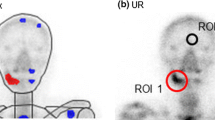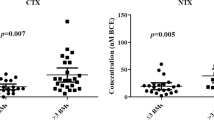Abstract
Objectives
The aim of this study was to evaluate the role of bone scintigraphy (BS) in early prediction of clinically asymptomatic bisphosphonate (BP)-related osteonecrosis of the jaws (BRONJ) in patients with metastatic castration-resistant prostate cancer (mCRPC).
Material and methods
BS of mCRPC patients treated with BP was evaluated for pathologic tracer uptake of the jaws in BS suspicious for BRONJ. Results were compared to development of clinically evident BRONJ. Sensitivity, specificity and predictive values of BS for the detection of BRONJ as well as time from beginning of BP therapy to pathologic tracer uptake in BS and time from pathologic tracer uptake in BS to clinically evident BRONJ were determined.
Results
Thirty BP-treated patients were included. Nine patients (30 %) had pathologic BS lesions of the jaws. Six patients (20 %) developed BRONJ. Sensitivity and specificity of BS for BRONJ prediction were 67 and 79 %. Median time from the start of BP treatment to pathologic tracer uptake in BS was 28 months (range 10–33) and from pathologic tracer uptake in BS to clinically evident BRONJ 6.5 months (range 2–19). Pathologic tracer uptake in BS was significantly more often observed in patients who developed BRONJ compared to patients who did not (p = 0.049; OR 7.6).
Conclusions
Patients with pathologic tracer uptake in the jaws in BS significantly more often develop BRONJ. An unsuspicious BS is predictive for absence of BRONJ in the future.
Clinical relevance
We conclude that when BS has been performed, it should not only be used to assess tumour stage and treatment response but also to check for pathologic tracer uptake in the jaws in BS to detect BRONJ at an early stage in mCRPC patients receiving bisphosphonates.

Similar content being viewed by others
References
Gandaglia G, Karakiewicz PI, Briganti A, Briganti A, Passoni NM, Schiffmann J, et al (2014) Impact of site of metastases on survival in patients with metastatic prostate cancer. Eur Urol S0302-2838(14):00672–00671. doi:10.1016/j.eururo.2014.07.020
Hagiwara M, Oglesby AK, Chung K, Zilber S, Delea TE (2011) The impact of bone metastases and skeletal-related events on healthcare costs in prostate cancer patients receiving hormonal therapy. Commun Oncol 8(11):508–515
Saad F, Gleason DM, Murray R, Tchekmedyian S, Venner P, Lacombe L, et al (2002) (2002) A randomized, placebo-controlled trial of zoledronic acid in patients with hormone-refractory metastatic prostate carcinoma. J Natl Cancer Inst 94(19):1458–1468
Lage MJ, Barber BL, Harrison DJ, Jun S (2008) The cost of treating skeletal-related events in patients with prostate cancer. Am J of Manag Care 14(5):317–322
Marx RE (2003) Pamidronate (Aredia) and zoledronate (Zometa) induced avascular necrosis of the jaws: a growing epidemic. J Oral Maxillofac Surg 61(9):1115–1117
Walter C, Al-Nawas B, Grotz KA, Thomas C, Thuroff JW, Zinser V, et al (2008) Prevalence and risk factors of bisphosphonate-associated osteonecrosis of the jaw in prostate cancer patients with advanced disease treated with zoledronate. Eur Urol 54(5):1066–1072
Wang EP, Kaban LB, Strewler GJ, Raje N, Troulis MJ (2007) Incidence of osteonecrosis of the jaw in patients with multiple myeloma and breast or prostate cancer on intravenous bisphosphonate therapy. J Oral Maxillofac Surg 65(7):1328–1331
Bamias A, Kastritis E, Bamia C, Moulopoulos LA, Melakopoulos I, Bozas G, et al (2005) Osteonecrosis of the jaw in cancer after treatment with bisphosphonates: incidence and risk factors. J Clin Oncol 23(34):8580–8587
Garcia Saenz JA, Lopez Tarruella S, Garcia Paredes B, Rodriguez Lajusticia L, Villalobos L, Diaz Rubio E (2007) Osteonecrosis of the jaw as an adverse bisphosphonate event: three cases of bone metastatic prostate cancer patients treated with zoledronic acid. Med Oral, Patol Oral Cir Bucal 12(5):E351–E356
Walter C, Sagheb K, Bitzer J, Rahimi-Nedjat R, Taylor KJ (2014) Analysis of reasons for osteonecrosis of the jaws. Clin Oral Investig 18(9):2221–2226
Rupel K, Ottaviani G, Gobbo M, Contrado L, Tirelli G, Vescovi P, et al (2014) A systematic review of therapeutical approaches in bisphosphonates-related osteonecrosis of the jaw (BRONJ). Oral Oncol 50(11):1049–1057
Ziebart T, Pabst A, Klein MO, Kämmerer P, Gauss L, Brüllmann D, et al (2009) Bisphosphonates: restrictions for vasculogenesis and angiogenesis: inhibition of cell function of endothelial progenitor cells and mature endothelial cells in vitro. Clin Oral Investig 15(1):105–111
Pabst AM, Ziebart T, Ackermann M, Konerding MA, Walter C (2014) Bisphosphonates’ antiangiogenic potency in the development of bisphosphonate-associated osteonecrosis of the jaws: influence on microvessel sprouting in an in vivo 3D Matrigel assay. Clin Oral Investig 18(3):1015–1022
Pabst AM, Ziebart T, Koch FP, Taylor KY, Al-Nawas B, Walter C (2012) The influence of bisphosphonates on viability, migration, and apoptosis of human oral keratinocytes-in vitro study. Clin Oral Investig 16(1):87–93
Walter C, Klein MO, Pabst A, Al-Nawas B, Duschner H, Ziebart T (2009) Influence of bisphosphonates on endothelial cells, fibroblasts, and osteogenic cells. Clin Oral Investig 14(1):35–41
Stockmann P, Hinkmann FM, Lell MM, Fenner M, Vairaktaris E, Neukam FW, et al (2010) Panoramic radiograph, computed tomography or magnetic resonance imaging. Which imaging technique should be preferred in bisphosphonate-associated osteonecrosis of the jaw? A prospective clinical study. Clin Oral Investig 14(3):311–317
Ruggiero SL, Dodson TB, Fantasia J, Goodday R, Aghaloo T, Mehrotra B, et al (2014) American Association of Oral and Maxillofacial Surgeons position paper on medication-related osteonecrosis of the jaw—2014 update. J Oral Maxillofac Surg 72(10):1938–1956
Hoff AO, Toth BB, Atundag K, Johnson MM, Warneke CL, Hu M, et al (2008) Frequency and risk factors associated with osteonecrosis of the jaw in cancer patients treated with intravenous bisphosphonates. J Bone Miner Res 23(6):826–836
Wilde F, Heufelder M, Winter K, Winter K, Hendricks J, Frerich B, et al (2011) The role of surgical therapy in the management of intravenous bisphosphonates-related osteonecrosis of the jaw. Oral Surg Oral Med Oral Pathol Oral Radiol Endod 111(2):153–163
Vescovi P, Manfredi M, Mergio E, Meleti M, Fornaini, Rocca JP, et al (2010) Surgical approach with Er:YAG laser on osteonecrosis of the jaws (ONJ) in patients under bisphosphonate therapy (BPT). Lasers Med Sci 25 (1): 101–113.
Lazarovici TS, Mesilaty-Gross S, Vered I, Pariente C, Kanety H, Givol N, et al (2010) Serologic bone markers for predicting development of osteonecrosis of the jaw in patients receiving bisphosphonates. J Oral Maxillofac Surg 68(9):2241–2247
Kwon YD, Kim DY, Ohe JY, Yoo JY, Walter C (2009) Correlation between serum C-terminal cross-linking telopeptide of type I collagen and staging of oral bisphosphonate-related osteonecrosis of the jaws. J Oral Maxillofac Surg 67(22):2644–2648
Kwon YD, Ohe JY, Kim DY, Chung DJ, Park YD (2011) Retrospective study of two biochemical markers for the risk assessment of oral bisphosphonate-related osteonecrosis of the jaws: can they be utilized as risk markers? Clin Oral Implants Res 22(1):100–105
Kunchur R, Need A, Hughes T, Goss A (2009) Clinical investigation of C-terminal cross-linking telopeptide test in prevention and management of bisphosphonate-associated osteonecrosis of the jaws. J Oral Maxillofac Surg 67(6):1167–1173
Lee CY, Suzuki JB (2010) CTX biochemical marker of bone metabolism. Is it a reliable predictor of bisphosphonate-associated osteonecrosis of the jaws after surgery? Part II: a prospective clinical study. Implant Dent 19(1):29–38
Don-Wauchope AC, Cole DE (2009) The (mis) use of bone resorption markers in the context of bisphosphonate exposure, dental surgery and osteonecrosis of the jaw. Clin Biochem 44(10–11):1194–1196
Baim S, Miller PD (2009) Assessing the clinical utility of serum CTX in postmenopausal osteoporosis and its use in predicting risk of osteonecrosis of the jaw. J Bone Miner Res 24(4):561–574
O’Ryan FS, Khoury S, Liao W, Han MM, Hui RL, Baer D, et al (2009) Intravenous bisphosphonate-related osteonecrosis of the jaw: bone scintigraphy as an early indicator. J Oral Maxillofac Surg 67 (7): 1363–1372.
Hong CM, Ahn BC, Choi SY, Kim DH, Lee SW, Kwon TG, et al (2012) Implications of three-phase bone scintigraphy for the diagnosis of bisphosphonate-related osteonecrosis of the jaw. Nuc Med Mol Imaging 46(3):162–168
Watters AL, Hansen HJ, Williams T, Chou JF, Riedel E, Halpern J, et al (2013) Intravenous bisphosphonate-related osteonecrosis of the jaw: long-term follow-up of 109 patients. Oral Surg Oral Med Oral Pathol Oral Radiol 115(2):192–200
Lapa C, Linz C, Bluemel C, Mottok A, Mueller-Richter U, Kuebler A, et al (2014) Three-phase bone scintigraphy for imaging osteoradionecrosis of the jaw. Clin Nucl Med 39:21–25
Acknowledgments
This study is part of the doctoral thesis of Magdalena Spanidis.
Conflict of interest
The authors declare that they have no competing interests.
Funding
None.
Author information
Authors and Affiliations
Corresponding author
Additional information
Christian Walter and Matthias Miederer contributed equally as senior authors.
Rights and permissions
About this article
Cite this article
Thomas, C., Spanidis, M., Engel, C. et al. Bone scintigraphy predicts bisphosphonate-induced osteonecrosis of the jaw (BRONJ) in patients with metastatic castration-resistant prostate cancer (mCRPC). Clin Oral Invest 20, 753–758 (2016). https://doi.org/10.1007/s00784-015-1563-8
Received:
Accepted:
Published:
Issue Date:
DOI: https://doi.org/10.1007/s00784-015-1563-8




